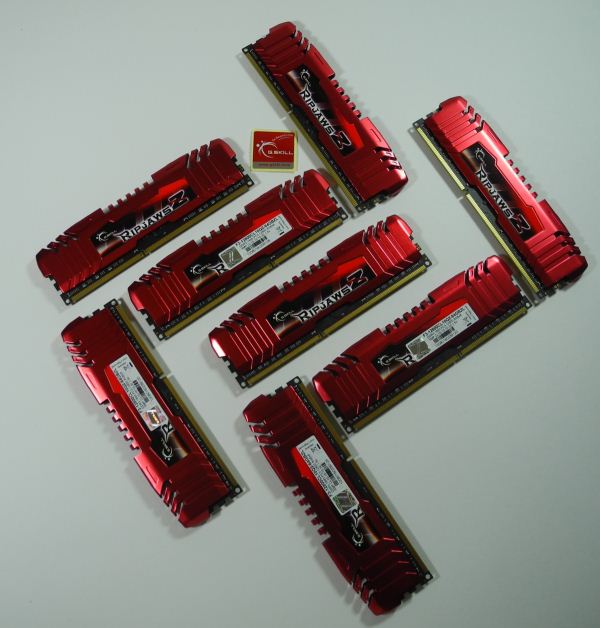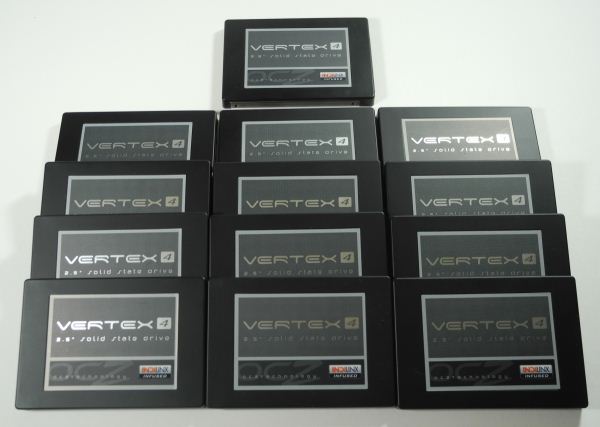Building the 2012 AnandTech SMB / SOHO NAS Testbed
by Ganesh T S on September 5, 2012 6:00 PM EST- Posted in
- IT Computing
- Storage
- NAS
Memory
The eight DIMM slots in the Z9PE-D8 WS allow up to 64GB of DRAM. Intel NASPT (one of our anticipated VM workloads) requires a minimum of 1GB of DRAM and doesn’t really like 4GB (as it introduces caching effects and leads to anomalous benchmarking results). Even low end clients in SMB environments come with a minimum of 2GB of DRAM nowadays, and hence, we decided to go with 2GB of DRAM for each VM. As SMB NAS speeds approach 200 MBps, it is sometimes necessary to have data sources and sinks capable of handling such speeds for file transfer tests. One option would be to have a really fast SSD or SSDs in RAID0. However, this introduces unnecessary extra variables into the mix. A RAM disk makes for a better solution, and in our build, also acts as a common storage resource for multiple VMs.
Keeping the above factors in mind, we decided to max out the capabilities of the Z9PE-D8 WS by installing 64GB of DRAM. We used G.Skill’s RipjawsZ F3-12800CL10Q2-64GBZL (8Gx8) modules. This quad-channel DDR3 kit is rated for operation at 1.5V and 1600 MHz with a CAS latency of 10-10-10-30. For our application, no overclocking was necessary. The Z9PE-D8 WS BIOS actually set it to 1333 MHz by default. We did find the performance at that setting to be good enough for our workloads, but decided to run the DIMMs at the native setting in the final configuration. Even though G.Skill targets the X79 platform, we had no trouble using it with the Z9PE-D8 WS. The combination of high capacity and efficiency made the G.Skill RipjawsZ a good choice for our testbed.
Storage
The storage subsystem is one of the most important aspects in a build meant to host multiple VMs concurrently. In our earlier NAS testbed, we used to run our VMs off a Seagate 2TB hard drive which had the host OS and the VMs in separate partitions. However, this is not a suitable solution for running multiple VMs concurrently. Hence, we made a decision to devote one physical disk to each VM. Fortunately, the Z9PE-D8 WS had 14 SATA ports.
Our planned workload doesn’t involve the storage of massive media files or any other such data which calls for hard disk drives in the testbed. The only exception is the robocopy test where we transfer a Blu-ray folder structure (with a size of 10.7GB) to the NAS and back. It is quite easy to handle that with a RAM disk, and hence, we decided to go with an SSD-only build.
We decided to equip the testbed with a 128GB OCZ Vertex 4 SSD for the host OS (Windows Server 2008 R2) and devote one 64GB OCZ Vertex 4 SSD to each VM. During the initial installation, we found that Windows Server 2008 R2 recommended at least 80GB of disk space for the primary partition. With the necessity to store temporary files for 12 VMs at the same time, we would have run the host OS SSD very close to full capacity. To resolve this, we installed another 128GB SSD to store the VM data and other necessary softwares.
The 128GB OCZ Vertex 4 provides up to 560 MBps / 430 MBps sequential read / write performance, and 90K / 120K IOPS for 4KB random reads and writes. At idle, the power consumption is 1.3W and it shoots up to 2.5W when fully active. These numbers remain the same for the 64GB OCZ Vertex 4. However, the sequential read / write performance drops down to 460 MBps / 220 MBps and the IOPS for 4K random reads and writes come in at 70K / 85K. Our aim in going with an SSD-only build was to make sure that the system’s storage subsystem didn’t end up being a bottleneck for our VMs. The much lower power consumption (compared to several distinct hard disk drives) ends up being an added bonus.












74 Comments
View All Comments
Tor-ErikL - Thursday, September 6, 2012 - link
As always a great article and a sensible testbench which can be scaled to test everything from small setups to larger setups. good choice!However i would also like some type of test that is less geared towards technical performance and more real world scenarios.
so to help out i give you my real world scenario:
Family of two adults and two teenagers...
Equipment in my house is:
4 latops running on wifi network
1 workstation for work
1 mediacenter running XBMC
1 Synollogy NAS
laptops streams music/movies from my nas - usually i guess no more than two of these runs at the same time
MediaCenter also streams music/movies from the same nas at the same time
in adition some of the laptops browse all the family pictures which are stored on the NAS and does light file copy to and from the NAS.
The NAS itself downloads movies/music/tvshows and does unpacking and internal file transfers
My guess for a typical home use scenario there is not that much intensiv file copying going on, usually only light transfers trough mainly either wifi or 100mb links
I think the key factor is that usually there are multiple clients connecting and streaming different stuff that is the most relevant factor. at tops 4-5 clients
Also as mentioned difference on the different sharing protocols like SMB/CIFS would be interesting to se more details about.
Looking forward for the next chapters in your testbench :)
Jeff7181 - Thursday, September 6, 2012 - link
I'd be very curious to see tests involving deduplication. I know deduplication is found more on enterprise-class type storage systems, but WHS used SIS, and FreeNAS uses ZFS, which supports deduplication._Ryan_ - Thursday, September 6, 2012 - link
It would be great if you guys could post results for the Drobo FS.Pixelpusher6 - Thursday, September 6, 2012 - link
Quick Correction - On the last page under specs for the memory do you mean 10-10-10-30 instead of 19-10-10-30?I was wondering about the setup with the CPUs for this machine. If each of the 12 VMs use 1 dedicated real CPU core then what is the host OS running on? With 2 Xeon E5-2630Ls that would be 12 real CPU cores.
I'm also curious about how hyper-threading works in a situation like this. Does each VM have 1 physical thread and 1 HT thread for a total of 2 threads per VM? Is it possible to run a VM on a single HT core without any performance degradation? If the answer is yes then I'm assuming it would be possible to scale this system up to run 24 VMs at once.
ganeshts - Thursday, September 6, 2012 - link
Thanks for the note about the typo in the CAS timings. Fixed it now.We took a punt on the fact that I/O generation doesn't take up much CPU. So, the host OS definitely shares CPU resources with the VMs, but the host OS handles that transparently. When I mentioned that one CPU core is dedicated to each VM, I meant that the Hyper-V settings for the VM indicated 1 vCPU instead of the allowed 2 , 3 or 4 vCPUs.
Each VM runs only 1 thread. I am still trying to figure out how to increase the VM density in the current set up. But, yes, it looks like we might be able to hit 24 VMs because the CPU requirements from the IOMeter workloads are not extreme.
dtgoodwin - Thursday, September 6, 2012 - link
Kudos on excellent choice of hardware for power efficiency. 2 CPUs, 14 network ports, 8 sticks of RAM, and a total of 14 SSDS idling at just over 100 watts is very impressive.casteve - Thursday, September 6, 2012 - link
Thanks for the build walkthrough, Ganesh. I was wondering why you used a 850W PSU when worst case DC power use is in the 220W range? Instead of the $180 Silverstone Gold rated unit, you could have gone with a lower power 80+ Gold or Platinum PSU for less $'s and better efficiency at your given loads.ganeshts - Thursday, September 6, 2012 - link
Just a hedge against future workloads :)haxter - Thursday, September 6, 2012 - link
Guys yank those NICs and get a dual 10gbe card in place. SOHO is 10Gbe these days. What gives? How are you supposed to test SOHO NAS with each VM so crippled?extide - Thursday, September 6, 2012 - link
10GBe is certainly not SOHO.